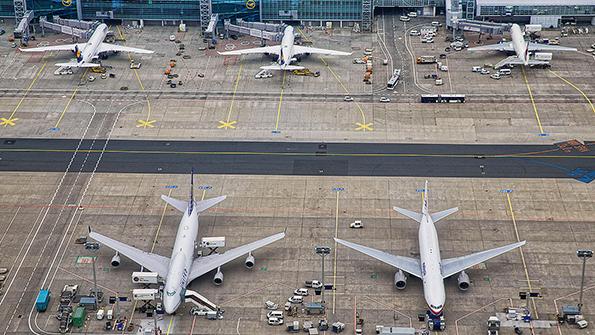Global Connecting Hubs Confront Daunting COVID-19 Challenges

For decades, giant connecting hubs have dominated the intricate webs that comprise the modern air transport system. But now the hub-dominated system is facing its most severe threat yet as the COVID-19 pandemic starves the networks of their feed.
All airline business models are under immense pressure, but the global connecting hubs seem particularly vulnerable. They rely on a critical mass of connecting routes that have all but disappeared due to border restrictions. The big question now is when—and whether—networks and flights will return in sufficient numbers to make the hub model thrive as it did before.
Of course, the major problem is that city-pair routes have been seriously reduced. A recent study by the International Air Transport Association (IATA) highlights how badly global connectivity has been eroded during 2020.
- Transit traffic under greater pressure than nonstop
- Hub model retains advantages and will recover
The IATA study uses several measures to assess connectivity. This indicated a significant increase in connectivity across all regions over the five years through 2019, up about 40% in Europe and the Asia-Pacific region and 26% in North America.
However, the emergence of the coronavirus caused a sharp reversal in 2020. The Asia-Pacific region saw a 76% year-over-year drop in connectivity, with North America down 73% and the other regions falling by about 90%. The Asia-Pacific and North American regions had smaller declines than elsewhere because they include countries with large domestic networks that were less affected by travel restrictions.
Before the pandemic, Asia-Pacific had 6,270 city-pair routes with either one or both ends within the region, including domestic links. However, by April this had dropped sharply to 4,020 city pairs. Excluding Chinese domestic routes, there were 4,070 city pairs pre-COVID-19 and 1,880 in April.
The Asia-Pacific region has some of the industry’s major connecting hubs, and they are extremely important to their home airlines—Cathay Pacific and Singapore Airlines, for example.
At Singapore Changi International Airport, total weekly seats are down by 87.5% year-over-year for the week of Dec. 7, according to data from CAPA – Centre for Aviation and OAG. Singapore Airlines will “not be able to have the similar complexity of connecting banks that we had pre-COVID-19 given the big reduction in services, but we have made sure that the key connecting corridors are able to flow through,” says Lee Lik Hsin, the airline’s executive vice president for commercial.
Transit traffic has been affected in this region due to both regulatory barriers and more practical challenges, says Vinoop Goel, IATA’s Asia-Pacific regional director for airports and external relations.
In many countries, connecting traffic is allowed with few restrictions as long as passengers are kept separate and remain in airport transit areas, Goel says. Hong Kong and Singapore have resumed transit to certain markets through their airports, as the governments recognize the importance of the connecting model to their local airlines.
But there are other places where governments have imposed heavy regulatory or operational constraints on transit. Goel says IATA and the airlines are trying to address these cases.
There are many reasons why connecting flights via a hub are not as attractive to passengers now. For one thing, the large number of closed borders means there are fewer one-stop opportunities available.
With significantly fewer flights out of hubs, “there are not enough convenient connections left” with a connecting time of 2-3 hr. or less, Goel says. In addition, for passengers taking two flights and going through three airports, navigating the different restrictions and rules “can be overwhelming.”
A recent study by McKinsey & Co. presents interesting findings about the role of transit hubs and how they have been affected by the pandemic.
The connecting-hub model was facing challenges even before the pandemic. At the global level, the share of connecting traffic fell to 17% in 2019, compared to 20% in 2005, the study shows, because of an increase in point-to-point flights, mainly by low-cost carriers in short-haul markets.
However, the opposite has been true for longer-haul intercontinental transit flows. Connecting traffic between Europe and North America was largely stable for the 14 years through 2019, while other intercontinental flows—including Asia to North America—have increased significantly over the same period. This trend has coincided with the growth of the so-called megahubs.
Transit flows have been particularly hard hit by the pandemic, the report says. While the volume of nonstop traffic was down 61% year-over-year in August, connecting traffic was down 81%.
This is due to changes on both the demand and supply side. On the demand side, there is simply less international long-haul travel due to border restrictions. Passengers are also more inclined to choose nonstop flights, the study says. On the supply side, cutbacks in flight schedules “have broken the connecting banks of many airlines.”
McKinsey cites the example of Frankfurt International Airport. In August 2019, passengers on inbound flights could connect to about 35 flights within a 1-4 hr. window, but a year later the potential connections available in that window had fallen to 11.
There will be some long-term challenges for the connecting-hub model after the pandemic. Customers naturally prefer nonstop flights, and the difference in price between nonstop and connecting itineraries could diminish after COVID-19, McKinsey states.
A larger challenge for hubs will be the continued introduction of new aircraft types. Aircraft such as Boeing 787s and Airbus A350s, and longer-haul narrowbodies like the A321LR, make more point-to-point routes viable to operate. This trend will be accelerated by the pandemic, with many older—and larger—aircraft being retired earlier than planned.
The study adds the caveat that the more efficient and longer-range aircraft types also can help the hub model, citing data that 40% of Boeing 787 capacity in 2019 was used on hub-to-hub routes and another 49% on hub-to-non-hub routes. This means just 11% of 787 capacity bypassed hubs altogether.
“The deployment of large and smaller widebody aircraft differs, but the vast majority of capacity continues to touch hubs,” the report says.
McKinsey suggests that some hubs, mainly those without large domestic markets, “will struggle in the short term” and “are at real risk of not surviving the lean years still to come” unless they adapt their operations.
The number of hubs will also be reduced as airlines with multi-hub systems streamline them to avoid duplication and increase efficiency, the report says.
While there will be “short-term pressure on hubs and fewer hubs in the longer term,” the transit hub model will remain relevant and viable, the report finds. “Its economic benefits—an efficient model for airlines and attractive prices for passengers—remain largely intact.” This means hubs should benefit from a predicted faster recovery in leisure demand versus business traffic.


